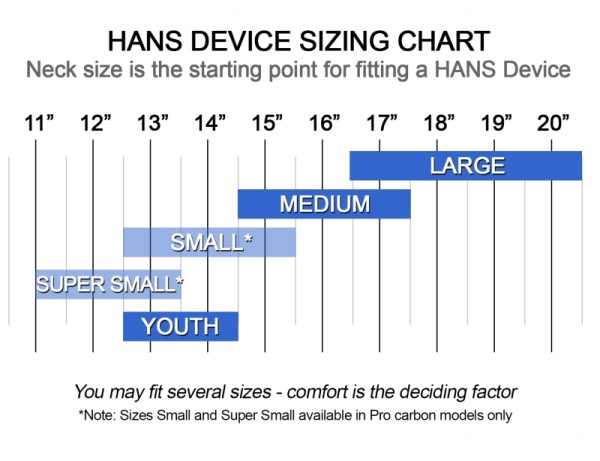Editor’s Note: June is OnAllCylinders safety month and will feature stories and tips on a variety of safety equipment.
The HANS Device has been around since the early 1980s but gained notoriety following the death of Dale Earnhardt in 2001. The U-shaped head and neck restraint was developed to keep the head from whipping forward and backward during a crash. The idea was to prevent fractures (basal fractures) at the base of the skull as the head is launched forward during accidents.
Before Earnhardt’s death, many motorsports drivers weren’t willing to wear the head and neck restraint, claiming it was uncomfortable and restrictive. However, a series of events, including Earhardt’s fatal crash at the Daytona 500, led to widespread (and sometimes reluctant) acceptance of the device. NASCAR made the HANS Device mandatory in 2001, followed by the NHRA and Formula 1 in 2003.
Most sanctioning bodies accept any head and neck restraint that meets the SFI 38.1 standard. Still, the HANS Device is the most recognized and trusted head and neck restraint and has even earned praise from racers who once refused to wear it. Whether you race at high speeds like the pros, or on a short track at relatively low speeds, a HANS Device could save you from serious or possibly fatal head and neck injuries.
We’ve put together this guide for choosing a HANS Device:
Step 1: Choose Your HANS Device
HANS Performance offers several styles of HANS Devices from which to choose. The differences are in the materials used and weight of the device itself. Here’s a quick overview of some of your HANS Device options:
Sport Series
- Budget design
- Injection molded super-structural carbon composite
- Weighs just 2 1/4 pounds
- SFI and FIA-approved
- Start at $549.00*
Sport II Series
- New injection molding reduces weight
- Smaller collar made from DuPont polymer reduces weight
- Weighs less than Sport Series but more than Pro Series
- SFI and FIA-approved
- Start at $549.00
Pro Series
- High modulus carbon fiber construction
- Weighs only one pound
- SFI and FIA-approved
- Trusted by NASCAR, World Rally, Formula 1, and more
- Start at $739.00
Adjustable Series
- Adjustable angle from 10 to 40 degrees in 5-degree increments for a custom feel
- SFI-approved
- Fits all types of race cars
- Start at $749.00
Step 2: Find Your Size
Once you’ve settled on the device you want, you’ll need to choose the right size for your neck. HANS Performance and Simpson Racing provide this sizing chart as a starting point:
Although you may fit a few different sizes, your comfort is ultimately the deciding factor.
Step 3: Choose the Right Angle
Next, you’ll need to narrow down your choice by matching your specific HANS Device to your seat angle. Some are available with two options; others come with three options. Depending on which model of HANS Device you select, here are your options:
- 0-10 degree angle: commonly used in Sprint Cars
- 20-degree angle: commonly used Modified, FIA, Stock Cars, or Sprints
- 30-degree angle: intended for racers weighing 200 pounds or more
Step 4: Pick Your Anchor and Tether
Finally, you’ll have to choose an anchoring system to attach the device to your helmet.
Most competition-approved helmets now come pre-drilled for HANS Devices (learn more about choosing a helmet here). If yours does not, you’ll need to drill holes in the proper locations using the instructions available with your helmet. Depending on the model you’ve chosen, you can typically get your HANS Device with post anchors or quick-click anchors to secure the tether to your helmet. HANS now offers sliding tethers for each model, giving you greater side-to-side vision and freedom when driving.
Here is more detailed information on anchor and tether installation, courtesy of hansdevice.com.
That’s the basic overview of how to choose a HANS Device; however, you can find more specific answers in response to these frequently asked questions:
HANS Device FAQs
What type of shoulder belts work best with a HANS Device? Any SFI- or FIA-approved shoulder harness system works fine with the HANS Device. Two- or three-inch shoulder belts in nylon or polyester work fine with the HANS Device. Be sure to mount and replace your belts in accordance with manufacturer guidelines. Only the HANS Device spreads the belts around your neck, preventing chafing and maximizing belt performance.
Do some shoulder belts slip off the HANS Device? No. Properly mounted belts do not slip off the device. If your shoulder belts will not stay securely on the device chances are that you do not have the belt mounts properly located in your chassis. When properly mounted, the HANS Device actually maximizes belt performance by spreading the belts around your neck, allowing the belts to be mounted as close together as possible for best performance. In more than 3,600 crashes involving HANS Device use as inspected by NASCAR, there was not one concern about belt retention or slippage.
Do I need a different HANS Device for each helmet? No. As long as each helmet is fitted with the proper anchors, you can use one HANS Device with multiple helmets. Because the HANS Device is the only head and neck restraint that directs the loads through the forehead area, you can use an open face helmet with the HANS Device, too.
When should I replace my HANS Device? Unless it saves your life in a major wreck, you may never have to replace your HANS Device. However, you will need to have your HANS Device recertified every five years to maintain SFI 38.1 approval.
Can I share a HANS Device? Yes, provided that you are of similar physical size and shape to your partner, chances are good that you can share a HANS Device. Both of you will need to have HANS anchors installed on your helmets.
Do I need a special helmet? No. HANS helmet anchors fit any competition-approved racing helmet. Because the HANS Device is the only head and neck restraint that directs the loads through the forehead area, you can use an open face helmet with the HANS Device, too.
How do I care for my HANS device? HANS Devices need almost no maintenance but should be kept clean and dry. Tethers are dated. Replace every 5 years, after major impacts or sooner if wear is observed. Extreme hot or cold environments should be avoided and they should be kept away from petroleum products and other corrosives as these can affect even the strongest composite materials and resins. To protect them, HANS Devices should be stored out of direct sunlight. They may be cleaned with soapy warm water.
When I put the device on, it rubs against my neck. Is that normal? Yes. The padding is adjustable and moving it away from the neck often remedies this concern. This is a compromise to allow the driver to have greater clearance for steering and other arm movements.



Hi David, A very good article. Can you let me know if there is a 3 dimensional, adjustable head model that can be purchased, that companies can use to size head devices such as helmets and other items ? Preferably, it could be adjusted for head sizes of different human populations. I am interested if one is available for purchase, as I teach Ergonomics and Anthropometry at the University of Cincinnati, DAAP College of Design. Thank you Howie
Hi !!! I have 1 HANS device 30 pro ultra lite, my weight is 164 P
Want to know if I can use this for formula and stock cars !!!
Thanks a lot
Walter